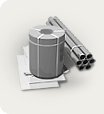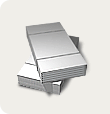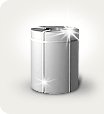In recent years, laptops have become significantly more popular than desktop computers. The reason for this is their mobility and the fact that, in terms of its technical characteristics, a laptop can completely replace a desktop home computer. The most important thing in keeping a laptop running, like any mobile device, is the battery. If the battery has aged and no longer holds a charge as long as it was in the beginning, you need to replace the battery. Many shops, companies and markets for computer spare parts offer various laptop batteries . Let's take a closer look at their varieties.
There are 4 main types of laptop batteries
- Nickel Cadmium (Ni-Cd) is an older type of battery. It contains heavy metals - "environmentally dirty", has a "memory effect", high self-discharge (discharge of an idle battery) - up to 10% in the first 24 hours, but it is not sensitive to temperature changes, does not heat up even when charged with high current, resource is more than 1000 recharge cycles. These batteries are low cost. "Memory effect" - a decrease in power that occurs when charging an incompletely discharged battery. It continues to be used primarily in construction power tools.
- Nickel metal hydride (Ni-MH) - this type replaced the previous one in the 80s of the XX century. Better than its predecessor in that with the same weight and dimensions it has a capacity of up to 50% more, "environmentally cleaner", "memory effect" is weaker. But it has a shorter resource (only 500 cycles), greater sensitivity to negative temperatures, at a price higher than its Ni-Cd counterpart by 30%, has a higher self-discharge than nickel-cadmium. Also used in electric vehicles.
- Lithium-ion (Li-Ion) - the most common batteries for laptops, mobile phones, video and photographic equipment. They appeared thanks to Sony in 1990. These batteries have a very high amount of energy per unit weight (energy density), they are light in weight and low self-discharge (2-5% per month), there is no "memory effect". The capacity is 2 times greater with a mass and value 30% less than NiCd and NiMH. Minus - a small range of operating temperatures (if not observed, it loses up to 70% of its capacity). The number of recharge cycles is from 300 to 500, and after 300 cycles (a year of use), the capacity is reduced by 80%. The battery begins its aging process. Another disadvantage is the high cost.
- Lithium-polymer (Li-polymer) - the so-called modified lithium-ion battery. It has a gel-like polymer electrolyte, can be used for small-sized gadgets (mobile phones, mp3-players), has no "memory effect", has a low price, and is environmentally friendly. Minus - battery






